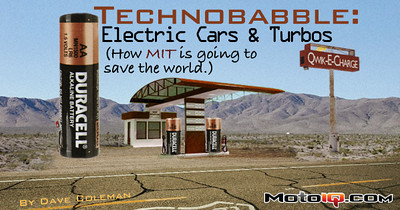,

Don’t cry for the gas man, though, because another team of MIT brainiacs are working to save the piston. Ethanol Boosting Systems (EBS), a new company founded by a bunch of guys whose titles start with Dr., and end with (MIT) recently spun off from the combustion research the good doctors were working on at school.
In this research, they were playing with E85 and figuring out how to take advantage of its fantastically high octane and combustion-cooling heat of vaporization, without having to suffer the craptastic gas mileage that results from E85’s low energy density, or the relative impossibility of trying to find the stuff anywhere outside the corn belt. If you could have the octane of E85 with the energy density and convenience of gasoline, what a wonderful world this would be.
Naturally, they found a way. Here’s how: It turns out that if you take an otherwise normal, port-injected gasoline engine, and you inject just a tiny amount of E85 directly into the combustion chamber using a conventional direct-injection system, you can get most of your energy from the gas, but get charge cooling and octane from the E85.
The brilliance of this strategy is that engines don’t need high octane most of the time. Idling in traffic, cruising down the freeway, accelerating like your mom; None of these require even 91 octane, let alone the 100+ octane of E85. So, in all these boring conditions, the engine can run purely on 87-octane crap. When pedal hits metal, though, a little bit of E85 joins the party, preventing knock and boosting power.
In fact, it turns out that if you inject the E85 in just the right quantity, location and timing, you can achieve a result far more effective than even the 100-octane E85 normally delivers. In fact, EBS claims they can achieve the functional equivalent of 150 octane with this method, which effectively eliminates the knock threshold entirely. Suddenly, the limits to how hard you can lean on an engine are now set by the mechanical limits of the parts, not the point at which the detonation starts breaking things.
This opens the door for staggering levels of turbocharging. Imagine a turbocharged engine with 13:1 compression AND 20 psi of boost. Now, imagine how much you could downsize an engine with that kind of power density. Imagine a 3-cylinder, 1-liter, 300-horsepower Mustang…
Rollin, in my one point oh!
Building an engine with this kind of power density results in something that looks more like a diesel than a conventional gas engine. Engine blocks have to be cast iron, pistons have to be stronger and a bit heavier, etc., etc., but that’s the only compromise. There’s really no new technology involved in implementing EBS’s strategy. Port injection for the gas, direct injection for the E85, both of which can use off-the shelf technology. Emissions control strategies are exactly the same as any other gas engine, which is to say much cheaper than trying to clean up a diesel.
Most drivers (the slow ones who should probably be in electric cars anyway) get into this high-octane realm so infrequently that a small tank of E85 (less than 5 gallons) could last through a 5,000-mile oil change interval, opening the door for this kind of dual-fuel engine to thrive even here in California, where there are currently less than 10 E85 stations in the entire state. E85 could simply be sold in bottles, like oil. Or, the system could be tuned to run on windshield washer fluid.
No, seriously. Windshield washer fluid is mostly methanol and water, and the system can work nearly as well injecting the blue bubbly stuff.
For now, Ethanol Boosting Systems is working closely with Ford, and is focusing on applying their technology to trucks and SUVs, an area where the net fuel savings from, say, a 25% improvement in fuel economy, will have the biggest impact on the number of gallons burned. Its also the area where an extra 5-gallon gas tank is unlikely to bother anybody.
Down in our world, though, I’m just waiting for these truck engines to be small enough to squeeze into a Miata.



